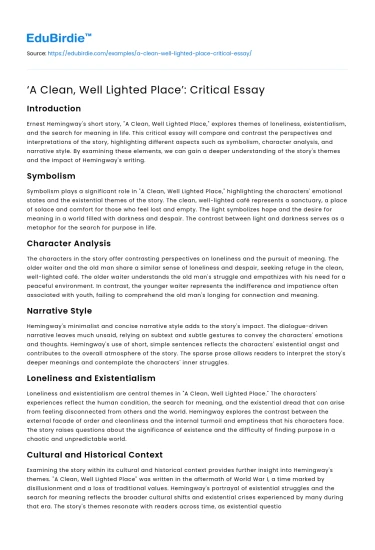Introduction
Ernest Hemingway's short story, "A Clean, Well Lighted Place," explores themes of loneliness, existentialism, and the search for meaning in life. This critical essay will compare and contrast the perspectives and interpretations of the story, highlighting different aspects such as symbolism, character analysis, and narrative style. By examining these elements, we can gain a deeper understanding of the story's themes and the impact of Hemingway's writing.
Symbolism
Symbolism plays a significant role in "A Clean, Well Lighted Place," highlighting the characters' emotional states and the existential themes of the story. The clean, well-lighted café represents a sanctuary, a place of solace and comfort for those who feel lost and empty. The light symbolizes hope and the desire for meaning in a world filled with darkness and despair. The contrast between light and darkness serves as a metaphor for the search for purpose in life.
Save your time!
We can take care of your essay
- Proper editing and formatting
- Free revision, title page, and bibliography
- Flexible prices and money-back guarantee
Character Analysis
The characters in the story offer contrasting perspectives on loneliness and the pursuit of meaning. The older waiter and the old man share a similar sense of loneliness and despair, seeking refuge in the clean, well-lighted café. The older waiter understands the old man's struggle and empathizes with his need for a peaceful environment. In contrast, the younger waiter represents the indifference and impatience often associated with youth, failing to comprehend the old man's longing for connection and meaning.
Narrative Style
Hemingway's minimalist and concise narrative style adds to the story's impact. The dialogue-driven narrative leaves much unsaid, relying on subtext and subtle gestures to convey the characters' emotions and thoughts. Hemingway's use of short, simple sentences reflects the characters' existential angst and contributes to the overall atmosphere of the story. The sparse prose allows readers to interpret the story's deeper meanings and contemplate the characters' inner struggles.
Loneliness and Existentialism
Loneliness and existentialism are central themes in "A Clean, Well Lighted Place." The characters' experiences reflect the human condition, the search for meaning, and the existential dread that can arise from feeling disconnected from others and the world. Hemingway explores the contrast between the external facade of order and cleanliness and the internal turmoil and emptiness that his characters face. The story raises questions about the significance of existence and the difficulty of finding purpose in a chaotic and unpredictable world.
Cultural and Historical Context
Examining the story within its cultural and historical context provides further insight into Hemingway's themes. "A Clean, Well Lighted Place" was written in the aftermath of World War I, a time marked by disillusionment and a loss of traditional values. Hemingway's portrayal of existential struggles and the search for meaning reflects the broader cultural shifts and existential crises experienced by many during that era. The story's themes resonate with readers across time, as existential questions and the desire for connection are universal human experiences.
Conclusion
Ernest Hemingway's "A Clean, Well Lighted Place" offers a poignant exploration of loneliness, existentialism, and the search for meaning in life. Through the use of symbolism, character analysis, narrative style, and examination of cultural context, readers can gain a deeper understanding of the story's themes and the impact of Hemingway's writing. The contrast between light and darkness, the characters' experiences of loneliness, and the minimalist narrative style all contribute to the story's enduring significance. "A Clean, Well Lighted Place" invites readers to contemplate the human condition and the inherent struggles we face in our pursuit of meaning and connection.






 Stuck on your essay?
Stuck on your essay?

